Product overview
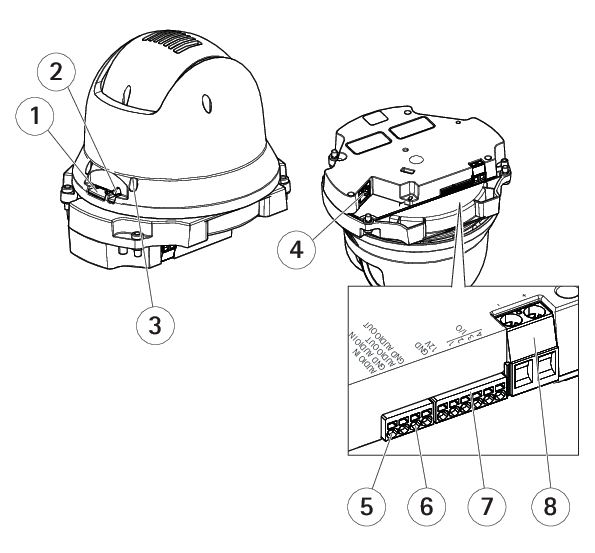
- SD card slot (microSD)
- Control button
- Status LED
- RJ45 connector
- Audio in
- Audio out
- I/O connector
- Power connector
How to connect a microphone to the camera
This example explains how to connect a microphone to the camera using an audio extension cable.
- Required hardware
AXIS T8351 Mk ll Microphone 3.5 mm
AXIS Audio Extension Cable B
- To avoid noise, don't run the cable close to or in parallel with other cables.
- To avoid noise, cut the cable as short as possible.
- To maintain IP66 rating, make sure you keep the jack inside the housing.
- Connect the cables
Keep the 3.5 mm jack and cut the audio extension cable.
Strip the outer cable insulation.
Strip the inner wire insulation.
Twist the audio wires (with insulation) together.
Twist the grounding wires (without insulation) together.
Connect the audio wires to the AUDIO IN pin on the camera. See Product overview.
Connect the grounding wires to the GND AUDIO IN pin on the camera.
Connect the microphone to the jack of the audio extension cable.
Turn on audio and adjust other audio settings in the camera's webpage.
Find the device on the network
To find Axis devices on the network and assign them IP addresses in Windows®, use AXIS IP Utility or AXIS Device Manager. Both applications are free and can be downloaded from axis.com/support.
For more information about how to find and assign IP addresses, go to How to assign an IP address and access your device.
Access the device
Open a browser and enter the IP address or host name of the Axis device.
If you do not know the IP address, use AXIS IP Utility or AXIS Device Manager to find the device on the network.
Enter the username and password. If you access the device for the first time, you must set the root password. See Set a new password for the root account.
The live view page opens in your browser.
Secure passwords
Use HTTPS (which is enabled by default) to set your password or other sensitive configurations over the network. HTTPS enables secure and encrypted network connections, thereby protecting sensitive data, such as passwords.
The device password is the primary protection for your data and services. Axis devices do not impose a password policy as they may be used in various types of installations.
To protect your data we strongly recommend that you:
Use a password with at least 8 characters, preferably created by a password generator.
Don’t expose the password.
Change the password at a recurring interval, at least once a year.
Set a new password for the root account
The default administrator username is root. If the password for root is lost, reset the device to factory default settings. See Reset to factory default settings
Type a password. Follow the instructions about secure passwords. See Secure passwords.
Retype the password to confirm the spelling.
Click Create login. The password has now been configured.
Additional settings
Need more help?
You can access the built-in help from the device’s webpage. The help provides more detailed information on the device’s features and their settings.
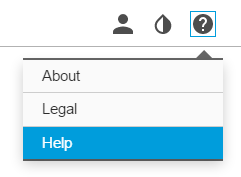
Image quality
Select exposure mode
There are different exposure mode options in the camera that adjusts aperture, shutter speed, and gain to improve image quality for specific surveillance scenes. Go to Settings > Image > Exposure and select between the following exposure modes:
For most use cases, select Automatic exposure.
For environments with certain artificial lighting, for example fluorescent lighting, select Flicker-free.
Select the same frequency as the power line frequency.
For environments with certain artificial light and bright light, for example outdoors with fluorescent lighting at night and sun during daytime, select Flicker-reduced.
Select the same frequency as the power line frequency.
To lock the current exposure settings, select Hold current.
Benefit from IR light in low-light conditions using night mode
Your camera uses visible light to deliver color images during the day. As the available light diminishes, you can set the camera to automatically shift to night mode, in which the camera uses both visible light and near-infrared light to deliver black-and-white images. Since the camera uses more of the available light it can deliver brighter, more detailed, images.
Go to Settings > Image > Day and night, and make sure that the IR cut filter is set to Auto.
Handle scenes with strong backlight
Dynamic range is the difference in light levels in an image. In some cases the difference between the darkest and the brightest areas can be significant. The result is often an image where either the dark or the bright areas are visible. Wide dynamic range (WDR) makes both dark and bright areas of the image visible.


- WDR can cause artifacts in the image.
- WDR may not be available for all capture modes.
Go to Settings > Image > Wide dynamic range.
Turn on WDR.
Use the Local contrast slider to adjust the amount of WDR.
If you still have problems, go to Exposure and adjust the Exposure zone to cover the area of interest.
Find out more about WDR and how to use it at axis.com/web-articles/wdr.
Verify the pixel resolution
To verify that a defined part of the image contains enough pixels to, for example, recognize the face of a person, you can use the pixel counter.
Go to Settings > System > Orientation.
Click .
In the camera’s live view, adjust the size and position of the rectangle around the area of interest, for example where you expect faces to appear.
You can see the number of pixels for each of the rectangle’s sides (X and Y), and decide if the values are enough for your needs.
Privacy masks
A privacy mask is a user-defined area that prevents users from viewing a part of the monitored area. In the video stream, privacy masks appear as blocks of solid color.
The privacy mask is relative to the pan, tilt, and zoom coordinates, so regardless of where you point the camera, the privacy mask covers the same place or object.
You’ll see the privacy mask on all snapshots, recorded video, and live streams.
You can use the VAPIX® application programming interface (API) to hide the privacy masks.
If you use multiple privacy masks it may affect the product’s performance.
You can create several privacy masks. Each mask can have 3 to 10 anchor points.
Hide parts of the image with privacy masks
You can create one or several privacy masks to hide parts of the image.
Go to Settings > Privacy mask.
Click New.
Adjust the size, color, and name of the privacy mask according to your needs.
Overlays
Overlays are superimposed over the video stream. They are used to provide extra information during recordings, such as a timestamp, or during product installation and configuration. You can add either text or an image.
Show a text overlay in the video stream when the device detects motion
This example explains how to display the text “Motion detected” when the device detects motion.
Make sure that AXIS Video Motion Detection is running:
Go to Settings > Apps > AXIS Video Motion Detection.
Start the application if it is not already running.
Make sure you have set up the application according to your needs. If you need help, see the user manual for AXIS Video Motion Detection 4.
- Add the overlay text:
Go to Settings > Overlay.
Select Create overlay and select Text overlay.
Enter
#Din the text field.Choose text size and appearance.
To position the text overlay, choose Custom or one of the presets.
- Create an action rule:
Go to Settings > System > Events > Action rules.
Create an action rule with AXIS Video Motion Detection as trigger.
From the list of actions, select Overlay text.
Type “Motion detected”.
Set the duration.
If you update the overlay text it will be automatically updated on all video streams dynamically.
Pan, tilt, and zoom (PTZ)
Limit the pan, tilt, and zoom movements
If there are parts of the scene that you don’t want the camera to reach, you can limit the pan, tilt, and zoom movements. For example, you want to protect the privacy of residents in an apartment building, which is located close to a parking lot that you intend to monitor. To limit the movements, go to Settings > PTZ > Limits.
Streaming and storage
Video compression formats
Decide which compression method to use based on your viewing requirements, and on the properties of your network. The available options are:
Motion JPEG
Motion JPEG, or MJPEG, is a digital video sequence that is made up of a series of individual JPEG images. These images are then displayed and updated at a rate sufficient to create a stream that shows constantly updated motion. For the viewer to perceive motion video the rate must be at least 16 image frames per second. Full motion video is perceived at 30 (NTSC) or 25 (PAL) frames per second.
The Motion JPEG stream uses considerable amounts of bandwidth, but provides excellent image quality and access to every image contained in the stream.
H.264 or MPEG-4 Part 10/AVC
H.264 is a licensed technology. The Axis product includes one H.264 viewing client license. To install additional unlicensed copies of the client is prohibited. To purchase additional licenses, contact your Axis reseller.
H.264 can, without compromising image quality, reduce the size of a digital video file by more than 80% compared to the Motion JPEG format and by as much as 50% compared to older MPEG formats. This means that less network bandwidth and storage space are required for a video file. Or seen another way, higher video quality can be achieved for a given bitrate.
Reduce bandwidth and storage
If you reduce the bandwidth it can result in loss of details in the picture.
Go to live view and select H.264.
Go to Settings > Stream.
Do one or more of the following:
Turn on dynamic GOP and set a high GOP length value.
Increase the compression.
Turn on dynamic FPS.
Set up network storage
- To store recordings on the network, you need to set up your network storage.
Go to Settings > System > Storage.
Click Setup under Network storage.
Enter the IP address of the host server.
Enter the name of the shared location on the host server.
Move the switch if the share requires a login, and enter username and password.
Click Connect.
Add audio to your recording
- Turn on audio:
Go to Settings > Audio and turn on Allow audio.
Go to Input > Type and select your audio source.
- Edit the stream profile which is used for the recording:
Go to Settings > Stream and click Stream profiles.
Select the stream profile and click Audio.
Select the checkbox and select Include.
Click Save.
Click Close.
Events
Set up rules for events
You can create rules to make your device perform an action when certain events occur. A rule consists of conditions and actions. The conditions can be used to trigger the actions. For example, the device can start a recording or send an email when it detects motion, or show an overlay text while the device is recording.
To learn more, see Get started with rules for events.
Direct the camera to a preset position when the camera detects motion
This example explains how to set up the camera to go to a preset position when it detects motion in the image.
- Make sure that AXIS Video Motion Detection is running:
Go to Settings > Apps > AXIS Video Motion Detection.
Start the application if it is not already running.
Make sure you have set up the application according to your needs. If you need help, see the user manual for AXIS Video Motion Detection 4.
Add a preset position:
Go to Settings > PTZ and set where you want the camera to be directed by creating a preset position.
- Create an action rule:
Go to Settings > System > Events > Action rules and add an action rule.
Type a name for the action rule.
From the list of triggers, select Applications and then select AXIS Video Motion Detection (VMD).
From the list of actions, select PTZ Control and then select Preset Position.
Select the preset position you want the camera to go to.
Click Ok.
Record video when a PIR detector senses motion
This example explains how to connect an Axis PIR detector to the camera, and set up the camera to start recording when the detector senses motion.
- Required hardware
3-wire cable (ground, power, I/O)
Axis PIR detector
Disconnect the camera from power before connecting the wires. Reconnect to power after all connections are done.
- Connect the wires to the camera’s I/O connector
- Note
For information on the I/O connector, see Connectors.
Connect the ground wire to pin 1 (GND/-).
Connect the power wire to pin 2 (12V DC output).
Connect the I/O wire to pin 3 (I/O input).
- Connect the wires to the PIR detector’s I/O connector
Connect the other end of the ground wire to pin 1 (GND/-).
Connect the other end of the power wire to pin 2 (DC input/+).
Connect the other end of the I/O wire to pin 3 (I/O output).
- Configure the I/O port in the camera’s webpage
Go to Settings > System > I/O ports.
Select Input in the Port 1 drop-down list.
Give the input module a descriptive name.
To make the PIR detector send a signal to the camera when it senses motion, select Closed circuit in the drop-down list.
To trigger the camera to start recording when it receives a signal from the PIR detector, you need to create an action rule in the camera’s webpage.
Use audio to deter intruders
This example explains how to connect a speaker to the camera and set it up to play a warning message when the camera detects motion in a restricted area.
- Required hardware
Active speaker with built-in amplifier and connecting wires
Make sure the camera is disconnected from power before making the connections. Reconnect to power after connecting the wires.
- Physical connection
Connect the audio wire from the speaker to the AUDIO OUT pin on the camera. See Product overview.
Connect the grounding wire from the speaker to the GND AUDIO OUT pin on the camera. See Product overview.
- Add audio clip to the camera
Go to Settings > Audio > Output and click to add your audio clip.
Click Add.
Select Upload under Add Audio Clip Options.
Browse to locate the audio clip and click Upload.
To trigger the camera to play the audio clip when it detects motion, create an action rule in the camera’s webpage.
Direct the camera and open the lock to a gate when someone is nearby
This example explains how to direct the camera and open a gate when someone wants to enter during daytime. This is done by connecting a PIR detector to the product’s input port and a switch relay to the product’s output port.
Required hardware
Mounted PIR detector
Switch relay connected to the gate lock, in this case the switch is normally closed (NC)
Connecting wires
Physical connection
Connect the wires from the PIR detector to the input pin, see I/O connector.
Connect the wires from the switch to the output pin, see I/O connector
Configure I/O ports
You need to connect the switch relay to the camera from the camera’s webpage. First, configure the I/O ports:
Set the PIR detector to an input port
Go to System > I/O ports.
Select Input in the Port 1 drop-down list.
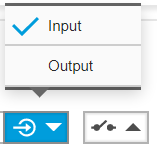
Give the input module a descriptive name, for example “PIR detector”.
To trigger an event whenever the PIR detector senses motion, select Open circuit in the drop-down list.
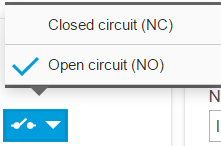
Set the switch relay to an output port
Go to System > I/O ports.
Select Output in the Port 2 drop-down list.
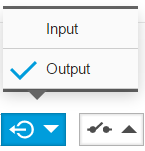
Give the output module a descriptive name, for example “Gate switch”.
To open the gate whenever an event is triggered, select Closed circuit in the drop-down list.
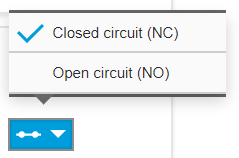
Create rules
For the camera to open the gate when the PIR detector senses someone nearby, you need to create a rule in the camera:
Go to System > Events > Action rules.
Click Add.
Give the action rule a name, for example “Open gate”.
In the Trigger drop-down menu, select Input signal.
Select Digital input signal.
Select ”PIR detector”, in this example connected to port 1.
Under Actions, select Output port from the Type drop-down menu.
In the Port drop-down menu, select “Gate switch”.
Click Ok.
Create another action rule with the name “Direct the camera to the gate".
Select the same input signal as before, but as action select the previously created “Gate entrance” preset position.
Click Ok.
Applications
Analytics and apps
With analytics and apps you can get more out of your Axis device. AXIS Camera Application Platform (ACAP) is an open platform that makes it possible for third parties to develop analytics and other apps for Axis devices. Apps can be preinstalled on the device, available for download for free, or for a license fee.
To find the user manuals for Axis analytics and apps, go to help.axis.com.
- Several apps can run at the same time but some apps might not be compatible with each other. Certain combinations of apps might require too much processing power or memory resources when run in parallel. Verify that the apps work together before deployment.
Troubleshooting
Reset to factory default settings
Reset to factory default should be used with caution. A reset to factory default resets all settings, including the IP address, to the factory default values.
To reset the product to the factory default settings:
Disconnect power from the product.
Press and hold the control button while reconnecting power. See Product overview.
Keep the control button pressed for 15–30 seconds until the status LED indicator flashes amber.
Release the control button. The process is complete when the status LED indicator turns green. The product has been reset to the factory default settings. If no DHCP server is available on the network, the default IP address is
192.168.0.90.Use the installation and management software tools to assign an IP address, set the password, and access the video stream.
The installation and management software tools are available from the support pages on axis.com/support.
It is also possible to reset parameters to factory default through the web interface. Go to Settings > System > Maintenance and click Default.
Check the current firmware
Firmware is the software that determines the functionality of network devices. One of your first actions when troubleshooting a problem should be to check the current firmware version. The latest version may contain a correction that fixes your particular problem.
To check the current firmware:
Go to the product’s webpage.
Click the help menu .
Click About.
Upgrade the firmware
Preconfigured and customized settings are saved when the firmware is upgraded (provided that the features are available in the new firmware) although this is not guaranteed by Axis Communications AB.
Make sure the product remains connected to the power source throughout the upgrade process.
When you upgrade the product with the latest firmware in the active track, the product receives the latest functionality available. Always read the upgrade instructions and release notes available with each new release before upgrading the firmware. To find the latest firmware and the release notes, go to axis.com/support/firmware.
AXIS Device Manager can be used for multiple upgrades. Find out more at axis.com/products/axis-device-manager.
Download the firmware file to your computer, available free of charge at axis.com/support/firmware.
Log in to the product as an administrator.
Go to Settings > System > Maintenance. Follow the instructions on the page. When the upgrade has finished, the product restarts automatically.
Technical issues, clues and solutions
If you can’t find what you’re looking for here, try the troubleshooting section at axis.com/support.
| Problems upgrading the firmware | |
Firmware upgrade failure | If the firmware upgrade fails, the device reloads the previous firmware. The most common reason is that the wrong firmware file has been uploaded. Check that the name of the firmware file corresponds to your device and try again. |
| Problems setting the IP address | |||
The device is located on a different subnet | If the IP address intended for the device and the IP address of the computer used to access the device are located on different subnets, you cannot set the IP address. Contact your network administrator to obtain an IP address. | ||
The IP address is being used by another device | Disconnect the Axis device from the network. Run the ping command (in a Command/DOS window, type
| ||
Possible IP address conflict with another device on the same subnet | The static IP address in the Axis device is used before the DHCP server sets a dynamic address. This means that if the same default static IP address is also used by another device, there may be problems accessing the device. | ||
| The device cannot be accessed from a browser | ||||||||||
Cannot log in | When HTTPS is enabled, ensure that the correct protocol (HTTP or HTTPS) is used when attempting to log in. You may need to manually type If the password for the user root is lost, the device must be reset to the factory default settings. See Reset to factory default settings. | |||||||||
The IP address has been changed by DHCP | IP addresses obtained from a DHCP server are dynamic and may change. If the IP address has been changed, use AXIS IP Utility or AXIS Device Manager to locate the device on the network. Identify the device using its model or serial number, or by the DNS name (if the name has been configured). If required, a static IP address can be assigned manually. For instructions, go to axis.com/support. | |||||||||
Certificate error when using IEEE 802.1X | For authentication to work properly, the date and time settings in the Axis device must be synchronized with an NTP server. Go to Settings > System > Date and time. | |||||||||
| The device is accessible locally but not externally | |||||||||||||||||
To access the device externally, we recommend using one of the following applications for Windows®:
For instructions and download, go to axis.com/vms. |
| Problems with streaming | |||||||||||||||||||
Multicast H.264 only accessible by local clients | Check if your router supports multicasting, or if the router settings between the client and the device need to be configured. The TTL (Time To Live) value may need to be increased. | ||||||||||||||||||
No multicast H.264 displayed in the client | Check with your network administrator that the multicast addresses used by the Axis device are valid for your network. Check with your network administrator to see if there is a firewall preventing viewing. | ||||||||||||||||||
Poor rendering of H.264 images | Ensure that your graphics card is using the latest driver. The latest drivers can usually be downloaded from the manufacturer’s website. | ||||||||||||||||||
Color saturation is different in H.264 and Motion JPEG | Modify the settings for your graphics adapter. Go to the adapter’s documentation for more information. | ||||||||||||||||||
Lower frame rate than expected |
| ||||||||||||||||||
Performance considerations
When you set up your system, it’s important to consider how different settings and situations affect performance. Some factors affect bandwidth (bitrate), others affect frame rate, and some affect both.
The most important factors to consider:
High image resolution or lower compression levels result in images containing more data which in turn affects the bandwidth.
Rotating the image in the GUI can increase the product's CPU load.
Access by large numbers of Motion JPEG clients or unicast H.264/H.265/AV1 clients affects the bandwidth.
Simultaneous viewing of different streams (resolution, compression) by different clients affects both frame rate and bandwidth.
Use identical streams wherever possible to maintain a high frame rate. Stream profiles can be used to ensure that streams are identical.
Accessing video streams with different codecs simultaneously affects both frame rate and bandwidth. For optimal performance, use streams with the same codec.
Heavy usage of event settings affects the product’s CPU load which in turn affects the frame rate.
Using HTTPS may reduce frame rate, in particular if streaming Motion JPEG.
Heavy network utilization due to poor infrastructure affects the bandwidth.
Viewing on poorly performing client computers lowers perceived performance and affects frame rate.
Running multiple AXIS Camera Application Platform (ACAP) applications simultaneously may affect the frame rate and the general performance.
Specifications
LED indicators
| Status LED | Indication |
| Unlit | Connection and normal operation. |
| Green | Shows steady green for 10 seconds for normal operation after startup completed. |
| Amber | Steady during startup. Flashes during device software upgrade or reset to factory default. |
| Amber/Red | Flashes amber/red if network connection is unavailable or lost. |
SD card slot
- Risk of damage to SD card. Don’t use sharp tools, metal objects, or excessive force when inserting or removing the SD card. Use your fingers to insert and remove the card.
- Risk of data loss and corrupted recordings. Unmount the SD card from the device’s web interface before removing it. Don’t remove the SD card while the product is running.
This device supports microSD/microSDHC/microSDXC cards.
For SD card recommendations, see axis.com.
![]()
![]()
![]() microSD, microSDHC, and microSDXC Logos are trademarks of SD-3C LLC. microSD, microSDHC, microSDXC are trademarks or registered trademarks of SD-3C, LLC in the United States, other countries or both.
microSD, microSDHC, and microSDXC Logos are trademarks of SD-3C LLC. microSD, microSDHC, microSDXC are trademarks or registered trademarks of SD-3C, LLC in the United States, other countries or both.
Buttons
Control button
- The control button is used for:
Resetting the product to factory default settings. See Reset to factory default settings.
Connectors
Network connector
RJ45 Ethernet connector with Power over Ethernet (PoE).
Audio connector
4-pin terminal block for audio input and output. See Product overview.
For audio in, the left channel is used from a stereo signal.
| Pin | Notes |
| AUDIO IN | Microphone or line in (mono) |
| GND AUDIO IN | Ground audio in |
| AUDIO OUT | Line audio out |
| GND AUDIO OUT | Ground audio out |
I/O connector
Use the I/O connector with external devices in combination with, for example, motion detection, event triggering, and alarm notifications. In addition to the 0 VDC reference point and power (12 V DC output), the I/O connector provides the interface to:
- Digital input
- For connecting devices that can toggle between an open and closed circuit, for example PIR sensors, door/window contacts, and glass break detectors.
- Digital output
- For connecting external devices such as relays and LEDs. Connected devices can be activated by the VAPIX® Application Programming Interface, through an event or from the device’s web interface.
6–pin terminal block. See Product overview.
| Function | Pin | Notes | Specifications |
| 0 V DC (-) | GND | DC ground | 0 V DC |
| DC output | 12 V | Can be used to power auxiliary equipment. Note: This pin can only be used as power out. | 12 V DC Max load = 50 mA |
| Configurable (Input or Output) | I/O 1–4 | Digital input – Connect to pin GND to activate, or leave floating (unconnected) to deactivate. | 0 to max 30 V DC |
| Digital output – Internally connected to pin 1 (DC ground) when active, and floating (unconnected) when inactive. If used with an inductive load, e.g. a relay, a diode must be connected in parallel with the load, for protection against voltage transients. | 0 to max 30 V DC, open drain, 100 mA |
Power connector
2-pin terminal block for DC power input. Use a Safety Extra Low Voltage (SELV) compliant limited power source (LPS) with either a rated output power limited to ≤100 W or a rated output current limited to ≤5 A.